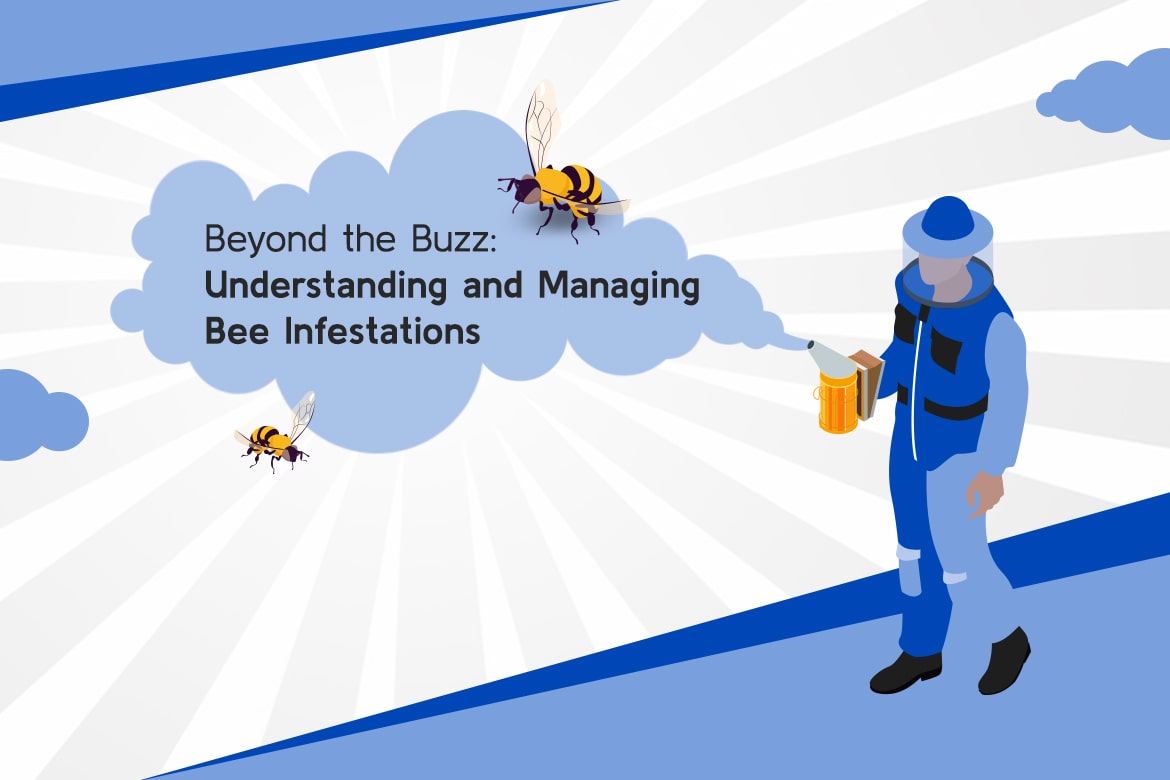Bees play a vital role in our ecosystem, but when they decide to take up residence in our homes or businesses, they can pose a challenge. In this blog, we delve into the intricacies of understanding and effectively managing bee infestations. By gaining insight into bee behaviour and employing appropriate management strategies, we at MET Pest Control can ensure the safety of both humans and bees.
The Biology of Bees
Bees are remarkable creatures with complex anatomy, behaviour, and nesting habits. Understanding these aspects is crucial for effective management of bee infestations. Bees typically live in colonies, with a queen bee, worker bees, and drones. Their intricate communication system and precise navigation skills allow them to forage for nectar and pollen efficiently. Various species of bees, such as honey bees, bumblebees, and solitary bees, each play unique roles in pollination and ecosystem health. Recognizing the differences between these species is essential for implementing targeted management strategies.
Signs of Bee Infestations
Bee infestations can escalate quickly if left unchecked, posing risks to both property and personal safety. Here’s an in-depth look at the signs of bee infestations and the associated risks:
- Increased Bee Activity: A sudden surge in bee activity around your property, particularly near eaves, windows, or doorways, is often a telltale sign of a nearby nest. Bees may exhibit frenzied behaviour as they enter and exit their nesting site, indicating the presence of a colony nearby.
- Audible Buzzing Sounds: Bees are known for their distinctive buzzing sounds, especially when they’re flying in and out of their nests. If you hear persistent buzzing sounds emanating from within your walls, attic, or other secluded areas of your home, it may indicate the presence of a bee colony nearby.
- Visible Nests: Keep a vigilant eye out for visible nests, which can vary in appearance depending on the species of bee. Common nest locations include trees, bushes, eaves, and even underground. Bees may construct intricate hives or simple nests depending on the species and environmental factors.
Bee infestations pose several risks, including:
- Stings: Bee stings can be painful and potentially dangerous, especially for individuals with allergies. Aggravating a bee colony or inadvertently disturbing their nesting site can result in aggressive behaviour and multiple stings, posing a significant health risk.
- Property Damage: Bees may build their nests in or around structures, including walls, attics, chimneys, and outdoor fixtures. Over time, the construction of these nests can cause structural damage, compromising the integrity of buildings and leading to costly repairs.
It’s essential to address bee infestations promptly to mitigate these risks and ensure the safety of occupants and property. Seeking professional assistance from pest control experts like MET Pest Control can help safely and effectively manage bee infestations while minimizing the potential for stings and property damage.
Managing Bee Infestations
When managing a bee infestation, prioritizing safe and responsible practices is essential to ensure the well-being of both humans and bees. Here’s a guide on how to handle bee infestations effectively:
- Safe Removal and Relocation: Opt for removal and relocation methods over extermination whenever possible. Bee colonies play a crucial role in pollination and ecosystem health, so preserving their populations is beneficial. Our staff are trained in safe removal and relocation techniques, ensuring the survival of the bees while removing them from your property. They utilize specialized equipment and protective gear to safely extract bee colonies without causing harm.
- Consulting with Professionals: Seek assistance from professionals who possess the expertise and equipment necessary to manage bee infestations ethically and eco-friendly. These professionals understand the behaviour and biology of bees, allowing them to devise appropriate removal strategies tailored to the specific infestation. By consulting with experts, you can ensure that bees are handled with care and that their colonies are relocated to suitable habitats where they can thrive.
By following these guidelines and collaborating with professionals, you can effectively manage bee infestations while promoting the conservation of these essential pollinators. Prioritizing ethical and eco-friendly practices not only protects your property but also contributes to the preservation of bee populations and the environment as a whole.
Preventive Measures
Implementing preventive measures is crucial to minimize the risk of bee infestations and maintain a bee-free environment around your home. Here’s a guide on how to keep bees at bay:
- Sealing Entry Points: Thoroughly inspect your home’s exterior for any cracks, gaps, or openings that could serve as entry points for bees. Seal these openings using caulk, weatherstripping, or other suitable sealants to prevent bees from gaining access. Pay close attention to areas around windows, doors, vents, and utility pipes, as bees can exploit even the smallest openings to infiltrate your home.
- Maintaining a Clean Outdoor Environment: Keep your outdoor areas tidy and free of clutter to deter bees from nesting on your property. Remove any debris, such as fallen branches, piles of leaves, or unused equipment, that could provide shelter or nesting sites for bees. Regularly mow the lawn, trim bushes and shrubs, and dispose of yard waste promptly to minimize potential nesting areas.
- Avoiding Flowering Plants Near the Home: While flowering plants are essential for pollinators like bees, strategically place them away from your home to reduce the likelihood of bee infestations. Bees are naturally attracted to nectar-rich flowers, so planting them too close to your home may inadvertently invite bees to nest nearby. Instead, create a buffer zone by planting flowering plants at a distance from your home or opt for non-flowering varieties in closer proximity.
By diligently implementing these preventive measures and maintaining a vigilant eye on your property, you can significantly reduce the risk of bee infestations and create a bee-friendly environment that promotes the well-being of these essential pollinators. Taking proactive steps to keep bees at bay not only protects your home and property but also contributes to the conservation of bee populations and the ecosystem as a whole.
In conclusion, bee infestations require a delicate balance of understanding, responsibility, and proactive management. By recognizing the signs of bee infestations, understanding the risks involved, and implementing preventive measures, homeowners can protect their properties while promoting the well-being of these essential pollinators.
We’ve discussed the importance of safe removal and relocation techniques for bee nests, as well as the significance of consulting with beekeeping professionals for ethical and eco-friendly solutions. Additionally, we’ve highlighted the legal considerations and regulations surrounding bee removal and management, emphasizing the need for compliance with local laws.
It’s crucial to take preventive measures to deter bees from nesting on your property, such as sealing entry points, maintaining a clean outdoor environment, and avoiding flowering plants near the home. By being proactive in pest management, homeowners can minimize the risk of bee infestations and create a safer living environment for themselves and their families.
At MET Pest Control, we understand the complexities of bee infestations and offer professional assistance for effective management solutions. Our team of experts is equipped with the knowledge and experience to handle bee infestations safely and responsibly, ensuring the well-being of both humans and bees.
Don’t wait until a bee infestation becomes a problem. Contact MET Pest Control today for comprehensive bee infestation management solutions tailored to your needs. Let’s work together to protect your home and promote a harmonious coexistence with nature.

